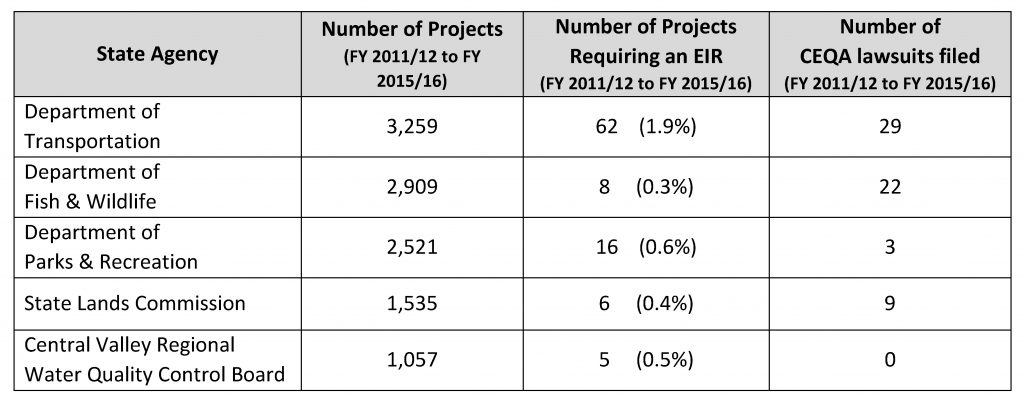Comprehensive New State Survey Shows California Environmental Quality Act Rarely Impedes New Projects
Study covered all state-led projects over a 5-year period
A constant complaint from many business leaders and their allies is the high cost of complying with the California Environmental Quality Act (CEQA), the state’s signature environmental law which requires environmental review for major new projects. But a new survey from the State of California shows that the law rarely affects most projects where the state is the lead agency.
The study examined all state-led projects over a five-year period, from 2011 to 2016. First, 90% of the state’s projects were already exempt from the law, due to compliance with legislative or regulatory provisions that exempt certain types of projects. Second, a full-blown environmental impact report occurred less than one percent of the time, while litigation was virtually negligible. Here is the summary chart:
 These findings are consistent with a 2016 study sponsored by the Rose Foundation, which found similarly low litigation rates statewide (Sean Hecht and I from this blog served as reviewers):
These findings are consistent with a 2016 study sponsored by the Rose Foundation, which found similarly low litigation rates statewide (Sean Hecht and I from this blog served as reviewers):
The number of lawsuits filed under CEQA has been surprisingly low, averaging 195 per year throughout California since 2002. Annual filings since 2002 indicate that while the number of petitions has slightly fluctuated from year to year, from 183 in 2002, to 206 in 2015, there is no pattern of overall increased litigation. In fact, litigation year to year does not trend with California’s population growth, at 12.5 percent overall during the same period.The rate of litigation compared to all projects receiving environmental review under CEQA is also very low, with lawsuits filed for fewer than 1 out of every 100 projects reviewed underCEQA that were not considered exempt. The estimated rate of litigation for all CEQA projects undergoing environmental review (excluding exemptions) was 0.7 percent for the past three years. This is consistent with earlier studies, and far lower than some press reports about individual projects may imply.
So while some in the big business (and big law) fields have gone to great lengths to portray CEQA and its attendant litigation as a major problem in the state, the data just aren’t matching (though “soft” costs, from defensive project siting and design, have still yet to be researched in any kind of meaningful way).
It’s still true that CEQA can be a barrier to new development. But based on the data so far, it’s just not a major one.







Reader Comments